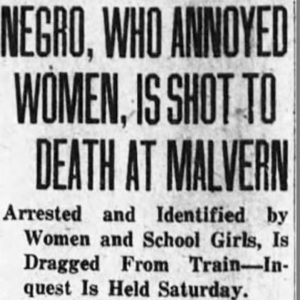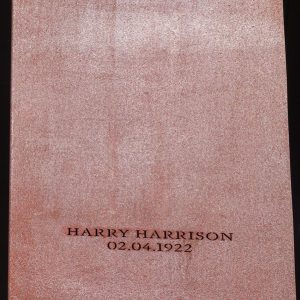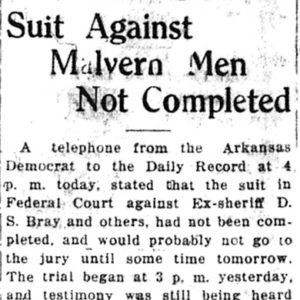calsfoundation@cals.org
John Henry Harrison (Lynching of)
On February 3, 1922, an African-American man was lynched in Malvern (Hot Spring County) for allegedly harassing white women and girls. While a number of newspaper accounts, as well as a National Association for the Advancement of Colored People (NAACP) annual report, identify him by the name of Harry Harrison, and the Arkansas Gazette identified him as John Harris, research conducted in large part by the Hot Spring County Historical Society indicated that his name was John Henry Harrison.
Harrison was living in Malvern at the time of the 1920 census; he was thirty-eight years old, married, and worked as a laborer in a lumber mill. He was a native of North Carolina and could both read and write. According to the Arkansas Gazette, he was well known in Malvern, as he had worked at the waterworks for several years.
Harrison was accused of harassing white women and girls in and near Malvern over a period of ten days by “appearing half-clad and making insulting remarks.” On January 30, he supposedly tried to stop a car full of girls as they were driving to Malvern High School. On February 1, he apparently followed several girls to their homes outside of town. On February 2, he allegedly approached the homes of several white women and threatened to attack them. One of these women, who frightened him off, contacted Sheriff Donald F. Bray, who found Harrison near her house. Harris refused to surrender and escaped to the lumber yards in nearby Walco (Hot Spring County), where he was eventually captured. A number of white workers joined Bray in pursuit and even threatened mob violence. The officers dissuaded them, and Harrison was taken to the homes of his accusers, who identified him, and then he was taken to jail, where he supposedly confessed.
On the evening of the February 3, Sheriff Bray decided to take Harrison to the Clark County Jail in Arkadelphia for safekeeping. Finding the roads out of town intentionally blocked by cars, he decided to travel by train instead. Bray, Harris, and two deputies boarded the train around 10:30 p.m., and Harrison was hidden under the seat in the “negro car.” According to the Malvern Daily Record, just as the train was beginning to leave, a masked man boarded and held the engineer at gunpoint. A masked mob of around twenty men detained the train until it could be searched.
Finding Harrison, they took him a short distance from the depot and, “without a word being spoken by either the members of the mob or the negro,” they shot him at least seventeen times. The mob dispersed quietly, and according to the Gazette, “The affair had been conducted in a quiet and orderly manner, and a majority of the people here knew nothing of the affair until this morning.” The body was taken to a local undertaker and was viewed by “visitors from all over the county.” On February 4, the coroner’s jury decided that Harris “came to his death at the hands of men unknown to the jury.” The only witnesses called were members of law enforcement, and the jury noted that it was impossible to identify the members of the mob because they were masked.
On October 23, 1923, the sister of Harrison, Callie Henry, filed suit against the Sheriff D. S. Bray, deputies W. T. Gamble and S. H. Leiper, and W. H. Cooper, alleging that authorities did not take the proper precautions to protect Harrison’s life. Attorney Scipio Jones aided Henry in receiving some financial assistance from the National Association for the Advancement of Colored People for the lawsuit, but she still needed to sell her home to pay for the lawyer. However, the United States District Court ultimately ruled against Henry in 1924 in her suit against local officials. She also filed suit on April 30, 1924, against against alleged leaders of the mob, including Clarence Chamberlain, R. S. Hodges, Leonard Stanley, and Ray Galina, but the court ruled against her the following year.
For additional information:
Carver, Danna K., and Gerald W. Williams. “The Lynching of John Henry Harrison.” The Heritage 49 (2022): 17–26.
Dillard, Tom. “A Murder with No Repercussions.” Arkansas Democrat-Gazette, January 23, 2021, p. 2H. Online at https://www.arkansasonline.com/news/2022/jan/23/a-murder-with-no-repercussions/ (accessed January 24, 2021).
“Masked Men Kill Negro.” Bisbee (Arizona) Daily Review, February 4, 1922, p. 1.
“Negro Killed by Unknown Persons.” Arkansas Gazette, February 5, 1922, p. 8.
“Negro, Who Annoyed Women, Is Shot to Death at Malvern.” Arkansas Democrat, February 4, 1922, p. 1.
“Negro Woman Is Loser in Lawsuit.” Arkansas Gazette, May 3, 1924.
“Negroes Lose Case against Malvern Men.” Malvern Daily Record, May 2, 1924, p. 1.
“A Real Woman!” Cleveland Gazette, March 28, 1925.
“Suit Based on Lynching of Negro Dismissed.” Arkansas Gazette, March 8, 1925.
Williams, Gerald W. “John Henry Harrison’s Genealogy Records.” The Heritage 49 (2022): 27–35.
Nancy Snell Griffith
Clinton, South Carolina
 Civil Rights and Social Change
Civil Rights and Social Change Early Twentieth Century, 1901 through 1940
Early Twentieth Century, 1901 through 1940 Harris Lynching Article
Harris Lynching Article  John Henry Harrison Lynching Article
John Henry Harrison Lynching Article  Hot Spring County Lynching
Hot Spring County Lynching  Lynching Lawsuit Article
Lynching Lawsuit Article 




Comments
No comments on this entry yet.